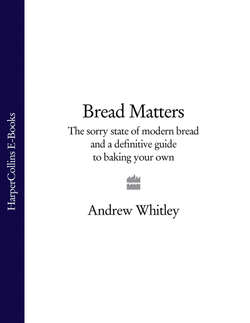Читать книгу Bread Matters: The sorry state of modern bread and a definitive guide to baking your own - Andrew Whitley - Страница 19
Yeast
ОглавлениеEver since our ancestors thousands of years ago noticed that a flour and water paste begins to aerate if left for some hours, people in wheat- and ryegrowing areas have eaten leavened bread. During fermentation, naturally occurring enzymes break carbohydrates down into sugars on which yeasts feed, producing carbon dioxide (the gas that raises the bread) and alcohol. This process was fully understood only after Louis Pasteur’s discovery in 1857 of the micro-organisms involved. It eventually became possible to identify and culture pure strains of yeast that gave fast and predictable results for breadmakers. Of the 160 or so known strains of yeast, the one commonly used for baker’s yeast is Saccharomyces cerevisiae. Other strains are involved in natural leavens and sourdoughs.
Before the development of commercial yeast in the late nineteenth century, bakers had to make their own, either with a ‘wild’ sourdough culture or by making a ‘barm’, which may have been seeded with yeast residue from a brewery. Either way, the process took time because the number of viable yeast cells in a sourdough or barm was relatively small. When commercial yeast became available, it contained much larger populations of cells and worked quickly. But it was expensive, and the thrifty baker could make it go further by using a small quantity in a preliminary ‘sponge’ consisting of a proportion of the flour and water to be used in the bread. This was allowed to ferment for 12 to 24 hours: given warmth, water and food, the yeast cells multiplied. On the following day, fresh flour and water (and occasionally some fat) would be added to make the final dough.
Even when commercial yeast became accessible to all bakers in the twentieth century, the ‘sponge-and-dough’ method remained a favoured way of breadmaking. In a typical overnight recipe from John Kirkland’s famous 1907 manual, The Modern Baker, Confectioner and Caterer, the yeast quantity is less than 0.1 per cent of the final dough weight. According to The Master Bakers’ Book of Breadmaking (National Association of Master Bakers, 1996), the Chorleywood Bread Process needs 2.38 per cent yeast for Vienna bread and rolls. In other words, over 23 times as much initial yeast as in Kirkland’s sponge-and-dough bread. Even compared with the fastest pre-War doughs, the Chorleywood Bread Process uses over three and a half times as much yeast.
If, after several decades in which most bread has been made with increased amounts of yeast, significant numbers of people develop an intolerance or allergy to yeast, it seems reasonable to ask whether there is a link. And there is another thing. Yeast, like the other raw materials of baking, has changed. It, too, needed a makeover if it was to be up to the task of Chorleywood baking. According to a manual for professional bakers, Baking Problems Solved (Stanley Cauvain and Linda Young, Woodhead Publishing Ltd, 2001):
‘When the CBP was introduced in the 1960s the type of baker’s yeast then used was unable to provide carbon dioxide gas in the critical early stages of baking and it became necessary for the yeast strain to be changed. Though the precise nature of the changes is not public knowledge it undoubtedly was related to the enzyme activity within the yeast cell.’ There’s an ominous note in that second sentence: the precise nature of the yeast used to make our national bread is ‘not public knowledge’. This was the 1960s – long (we thought) before the creeping capture of science by private business and certainly a good 20 years before the first emergence of genetic engineering.
